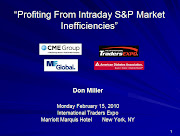I thought I'd do a brain dump on the market volatility in light of Steve & Doug's comments to Tuesday's post, along with a great related post by Dr. Brett today. Plus, it will get my mind off the Red Sox who are crumbling faster than investor portfolios. Luckily, I slept through the entire game.
As I do, please keep in mind as always this blog remains my "diary", and that I'm not providing trading advice. Having said that, there are no doubts these are extreme times ... extreme as they've ever been as evidenced among other things by a record high VIX and Dow & ES moves on Friday and Monday that completely obliterated previous records for movement in a day (Friday intraday range record & Monday a net gain record). In fact, according to Briefing.com, prior to Monday, the Dow's record point gain was +499 in March 2000. I believe there may have been a couple of higher % moves, but you get the point.
At the risk of stating the obvious, these are times no one has ever seen. Ever. And I've gotten caught at times. I had a 5% nick in my capital to start last week, and while I've fully recovered and more, have scrambled over the course of the last month a helluva lot than I'd like. Like many others, it has taken me getting whacked on the knees Tonya Harding style at times to keep this year's Bamboo Tree growing. In doing so, here are some lessons I've learned and adjustments I've tried to apply given the current environment.
Sizing - My largest loss a week ago Monday was largely the result of inappropriate sizing as the market was moving against me. That opening 90 minutes had to be among the most sustained selling ever at the open. I haven't traded close to that size since. The only way I've felt comfortable putting any size on lately ... and it's been rare ... is to put a partial position on and add slightly if the trade appears strong and begins to move in my direction so long as there's still adequate profit potential at the point of the second entry. By the way, while I haven't made much over the years trading the DAX, I firmly believe that trading it has greatly helped me adjust to the current ES pace.
During last Monday's personal debacle at the open, I had 500 contracts on at one time. For Friday's open I had a maximum positon of 90, and at today's open I only had 30 on.
Risk Management - Point-based stops are pretty useless in this environment, and if your initial entry is at a less than optimal wholesale entry point, even worse than useless. I've tried to manage by looking for "zones" of entry and through reduced size.
Chart & DOME Management - At various times, I've had to shrink my DOME to only show every other price Tick, or every fourth price Tick (a full point for ES) as well as adjust my 1-minute chart to 2-minute or simply ignore it and focus on the larger timeframe charts. Today's open was a good example where the gap up was clearly a pullback in a longer downtrend, and the lesser charts weren't as important aside from the smaller timeframes confirming the opening move south.
I've also found three line break charts helpful in filtering out much of the noise. Keep in mind 3LB requires a sustained trade above or below the current trend parameters to reverse, so a whipsaw 4 point swing that doesn't hold doesn't change the current trend in play ... assuming of course the market is trending on that timeframe, which it may not. Having said that, if one is fading extremes on clear overextensions -- a dangerous game at times in these conditions where extreme gets redefined hourly -- 3LB will always be against you. For example, the 1-min didn't turn north on Friday's open until ES had bounced significantly off the bottom.
I mentioned in the video the other day that sitting out "was and wasn't" an option ... with "was" being a possible scenario it we felt we couldn't trade a certain market. Perhaps keeping in mind the market will always be here, and that -- depending on our age -- we have thousands of days to trade over the course of a career will help us maintain the proper perspective in the current environment.
For the nimble, the current opportunities are there as emotions are at their historic peak. However, it only takes being being slightly off our game or one distraction or wrong move for opportunity to morph into losses which can easily accelerate as frustration and the market combine to provide a double whammy. That alone though doesn't make us "bad traders" ... I consider myself to be a good trader who makes occasional bad decisions.
These are historic times where defense may be more important as offense.
The market will always be here.
Tuesday, October 14, 2008
Subscribe to:
Post Comments (Atom)
















6 comments:
Thanks for those bonus thoughts on volatile market risk management.
It helps a lot to understand how you've adjusted and gives me some ideas for my next go round. Today I was just totally bullheaded on my too tight stops and ended up paying the price because of it.
But tomorrow's a new day...
Doug
Godspeed and keep up the good work. Thanks for the sharing, it has been an immeasurable help for my growth.
One thing I'd like to state for the benefit of Doug and Steve (and possibly others) is that the issue is not whether point stops work or not in this environment. If you were using point stops before, you don't have to abandon them, you just have to increase their size greatly.
For example I've done very well in this environment by simply taking what used to be 2 point stops and expanding them to 6 point stops or more. A chart is still a chart and a trend is still a trend. They just happen to be happening over huge ranges with three, four, or even five times the volatility as normal. So when I see a trade in a good area, I use a bigger stop, or if my stop is beyond a certain chart point it will naturally be larger by default because of the large ranges. On the day of the low I recognized that the volatility was unbelievably extreme, and I actually used 10 point stops. That was the only way to stay out of the noise and not get chopped up. And while in the normal trending environments my targets would be say 6 to 8 points for a decent trade on a 2 point stop, now they are 20 to 30 points on a 6 point or more stop. Same Risk/Reward. And this has worked quite well. Of course because my stops are larger, my position sizes are accordingly smaller to keep the dollar risk the same.
So in the end i don't think you have to abandon point stops at all; just adjust them by a factor that reflects the added volatility in the market.
Hope it helps.
Ziad
And while in the normal trending environments my targets would be say 6 to 8 points for a decent trade on a 2 point stop, now they are 20 to 30 points on a 6 point or more stop. Same Risk/Reward. And this has worked quite well. Of course because my stops are larger, my position sizes are accordingly smaller to keep the dollar risk the same.
That's the same conclusion I came to last night after staring at the ceiling all night. I guess what happened to Don last week happened to me yesterday.
Gotta adjust. Dr. Steenbarger's column today helped too.
Good ideas Ziad
Thanks Don, these are very helpful comments. As are Ziad's as well.
Thanks Ziad. Those were very useful suggestions and I've already modified my approach for these whippy days.
Doug
Note to Don:
Do you remember the old 80's TV show called Kids in the Hall? They did a cute skit that comes to mind when I need to recover from a bad trading day. It's good for a laugh whenever you have some spare time.
http://www.youtube.com/watch?v=3fDGsy7j53o
Post a Comment